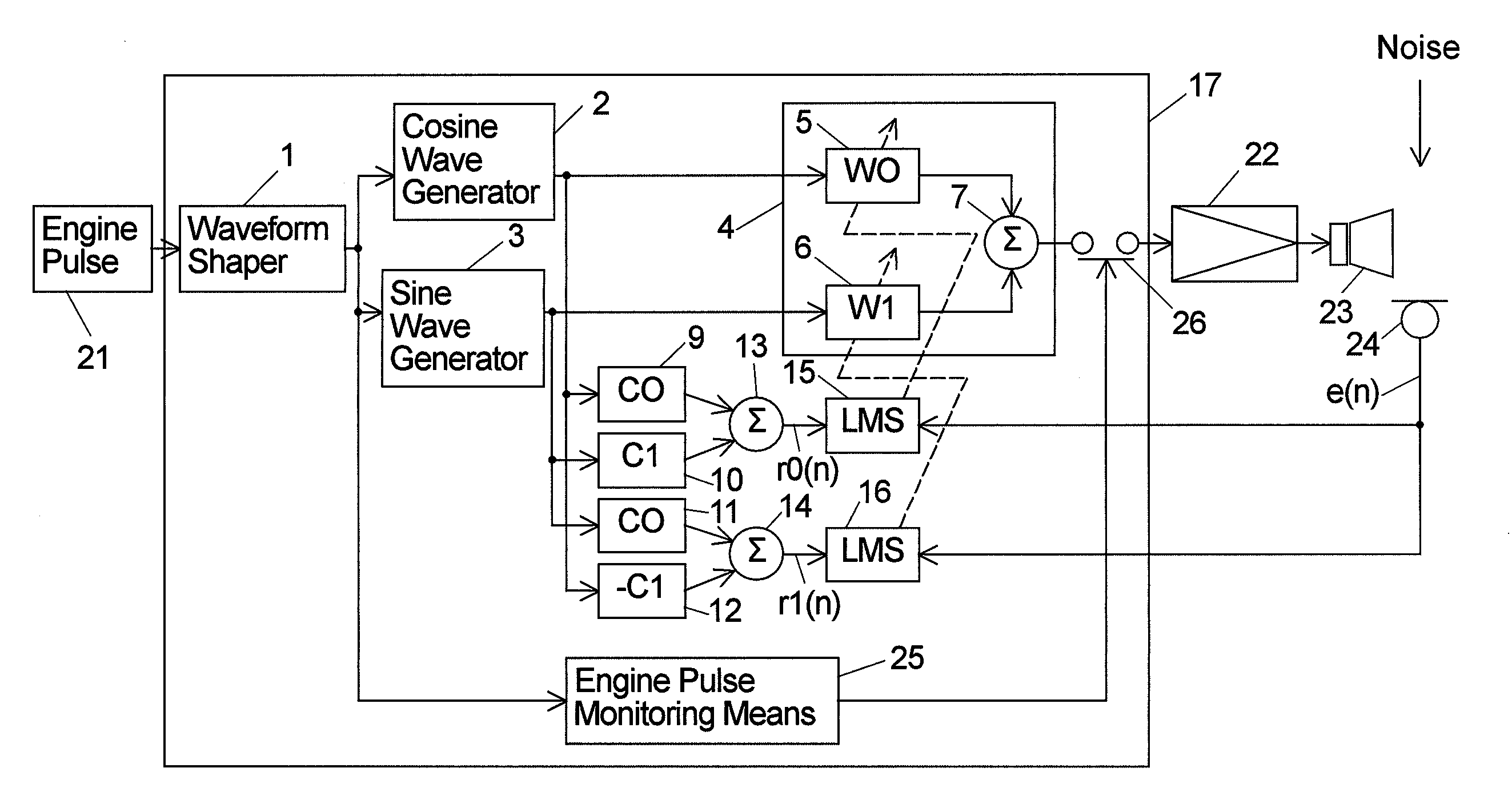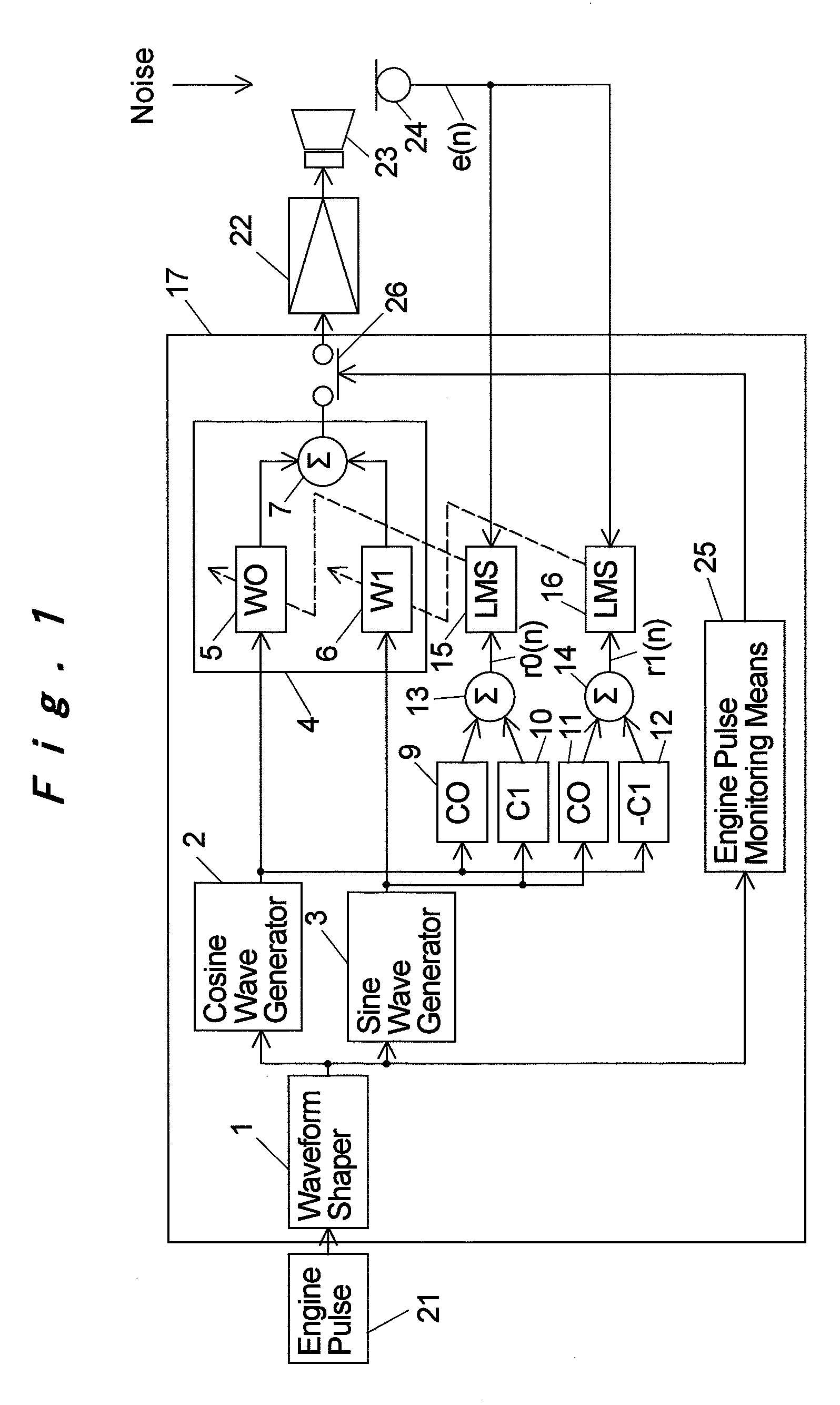Active Noise Control System
a technology of active noise and control system, applied in the direction of noise generation, instruments, ear treatment, etc., can solve the problem of abnormal sound generation
- Summary
- Abstract
- Description
- Claims
- Application Information
AI Technical Summary
Benefits of technology
Problems solved by technology
Method used
Image
Examples
first embodiment
[0020]FIG. 1 is a block diagram showing the configuration of an active noise control system according to a first embodiment of the present invention.
[0021]In FIG. 1, 21 denotes engine pulses of the engine, which is the source of noise that is to be reduced; this active noise control system operates to reduce cyclic noise radiated from the engine.
[0022]Engine pulse 21, which is an electric signal synchronizing with the engine rotation, is input to a waveform shaper 1, so that any noise or the like superposed to the signal is removed and the waveform is shaped. Output signals from a TDC (top dead center) sensor or tachometer pulses may be used as the engine pulses 21. Tachometer pulse data, in particular, is often provided to the vehicle side as an input signal from the tachometer, and so there is no need to provide a special device for the purpose.
[0023]Output signal from the waveform shaper 1 is input to a cosine wave generator 2 and a sine wave generator 3 to create a cosine wave a...
second embodiment
[0035]Next, a second embodiment will be described with reference to FIG. 2. FIG. 2 is a block diagram showing the configuration of an active noise control system according to the second embodiment. Like elements to those of the first embodiment are given the same reference numerals and will not be described again.
[0036]In this embodiment, as means of monitoring the engine for a sudden change of the condition, instead of the engine pulse monitoring means 25 of the first embodiment, sudden acceleration monitoring means 27 is provided, and it is configured that the output from the adaptive notch filters 4 into the secondary noise generating means is stopped using input stop means or the switch 26.
[0037]Acceleration degree, or the force applied to the acceleration pedal when it is pressed, is input to the sudden acceleration monitoring means 27, and it is constantly monitored whether the difference between the current value and one past value within a predetermined time period exceeds a...
third embodiment
[0039]Next, a third embodiment of the present invention will be described with reference to FIG. 3. FIG. 3 is a block diagram showing the configuration of an active noise control system according to the present embodiment. Like elements to those of the first embodiment are given the same reference numerals and will not be described again.
[0040]In this embodiment, as means of monitoring the engine for a sudden change of the condition, instead of the engine pulse monitoring means 25 of the first embodiment, shift-up monitoring means 28 is provided, and it is configured that the output from the adaptive notch filters 4 into the secondary noise generating means is stopped using an input stop means or the switch 26.
[0041]The shift-up monitoring means 28 turns off the switch 26 immediately when the transmission is shifted up. Thus, a sudden change in the engine pulses when the transmission is shifted up is detected, and it is prevented that abnormal sound is output from the adaptive notch...
PUM
 Login to View More
Login to View More Abstract
Description
Claims
Application Information
 Login to View More
Login to View More - R&D
- Intellectual Property
- Life Sciences
- Materials
- Tech Scout
- Unparalleled Data Quality
- Higher Quality Content
- 60% Fewer Hallucinations
Browse by: Latest US Patents, China's latest patents, Technical Efficacy Thesaurus, Application Domain, Technology Topic, Popular Technical Reports.
© 2025 PatSnap. All rights reserved.Legal|Privacy policy|Modern Slavery Act Transparency Statement|Sitemap|About US| Contact US: help@patsnap.com



